ESP VOLVO XC90 2007 User Guide
[x] Cancel search | Manufacturer: VOLVO, Model Year: 2007, Model line: XC90, Model: VOLVO XC90 2007Pages: 268, PDF Size: 8.57 MB
Page 150 of 268

2007 Volvo XC90
Positioning the load carriers
Make sure that the wing-shaped load carriers are installed on the roof r\
ails with the rounded edge forward (see the inset
illustration above). The load carriers are identical and can be placed \
anywhere along the roof rails.
When not in use, we recommend that the front load carrier be placed appr\
oximately 2 inches (5 cm) in front of the center
roof rail anchorage point and the rear load carrier approximately 1.5 in\
ches (3.5 cm) in front of the rear rail anchorage.
This will help to reduce wind noise.
NOTE: Volvo accessories mounted on these load carriers will require T-track m\
ounting hardware for correct installation.
Please consult your Volvo retailer.
Installing the load carriers
Make sure that the load carrier is pressed firmly out against the roof r\
ail. Screw the load carrier in place. Use the supplied
torque wrench and tighten to the mark on the wrench (corresponding to 6\
Nm). See illustration.
WARNING!
Loads carried on the vehicle's roof should not exceed 220 lbs (100 kg)\
, including the weight of the load carriers and any
other load carrying equipment (ski boxes, bicycle racks, etc.). Excess\
ive loads on the roof can adversely affect the
handling and roadholding characteristics of the vehicle.
pg. 142 Starting and driving
Load carriers (accessory)
file:///K|/ownersdocs/2007/2007_XC90/07xc90_06.htm (26 of 32)12/30/200\
6 5:53:44 PM
Page 153 of 268
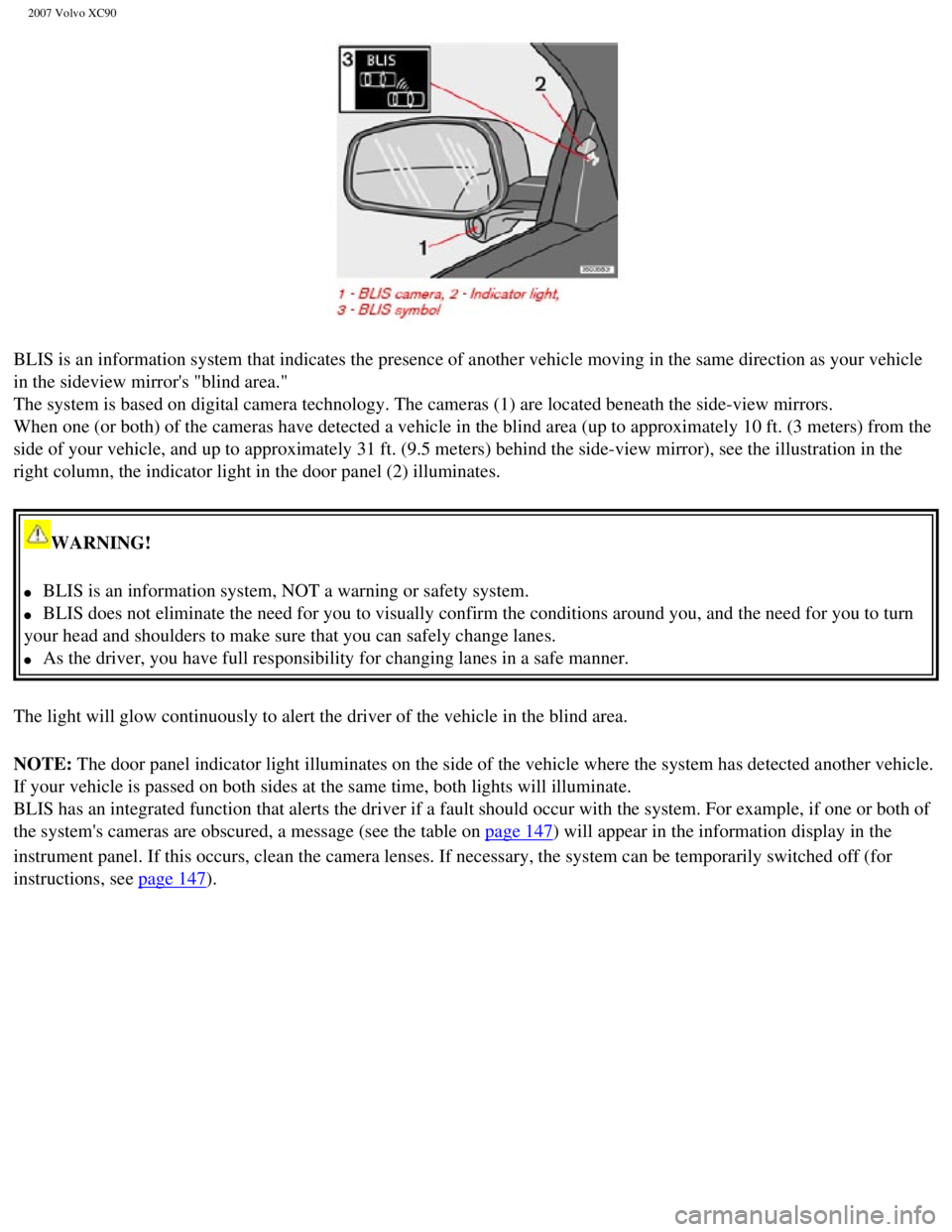
2007 Volvo XC90
BLIS is an information system that indicates the presence of another veh\
icle moving in the same direction as your vehicle
in the sideview mirror's "blind area."
The system is based on digital camera technology. The cameras (1) are \
located beneath the side-view mirrors.
When one (or both) of the cameras have detected a vehicle in the blind\
area (up to approximately 10 ft. (3 meters) from the
side of your vehicle, and up to approximately 31 ft. (9.5 meters) behi\
nd the side-view mirror), see the illustration in the
right column, the indicator light in the door panel (2) illuminates.
WARNING!
l BLIS is an information system, NOT a warning or safety system.
l BLIS does not eliminate the need for you to visually confirm the conditi\
ons around you, and the need for you to turn
your head and shoulders to make sure that you can safely change lanes.
l As the driver, you have full responsibility for changing lanes in a safe\
manner.
The light will glow continuously to alert the driver of the vehicle in t\
he blind area.
NOTE: The door panel indicator light illuminates on the side of the vehicle wh\
ere the system has detected another vehicle.
If your vehicle is passed on both sides at the same time, both lights wi\
ll illuminate.
BLIS has an integrated function that alerts the driver if a fault should\
occur with the system. For example, if one or both of
the system's cameras are obscured, a message (see the table on
page 147) will appear in the information display in the
instrument panel. If this occurs, clean the camera lenses. If necessary,\
the system can be temporarily switched off (for
instructions, see
page 147).
file:///K|/ownersdocs/2007/2007_XC90/07xc90_06.htm (29 of 32)12/30/200\
6 5:53:44 PM
Page 159 of 268

2007 Volvo XC90
General information
WARNING!
l The wheel and tire sizes for your Volvo are specified to meet stringent \
stability and handling
requirements. Unapproved wheel/tire size combinations can negatively aff\
ect your vehicle's stability
and handling. Approved tire sizes are shown in the Tire inflation pressu\
re tables on
page 154.
l Any damage caused by installation of unapproved wheel/tire size combinat\
ions will not be covered
by your new vehicle warranty. Volvo assumes no responsibility for death,\
injury, or expenses that
may result from such installations.
New tires
Remember that tires are perishable goods. As of 2000, the manufacturing \
week and year will be
indicated with 4 digits (e.g. 1502 means that the tire illustrated was \
manufactured during week 15 of
2002).
Tire age
Tires degrade over time, even when they are not being used. It is recomm\
ended that tires generally be
replaced after 6 years of normal service. Heat caused by hot climates, f\
requent high loading conditions
or Ultra Violet (U.V) exposure can accelerate the aging process.
You should replace the spare tire when you replace the other road tires \
due to the aging of the spare.
A tire's age can be determined by the DOT stamp on the sidewall (see th\
e illustration above).
A tire with e.g., visible cracks or discoloration should be replaced imm\
ediately.
Improving tire economy:
l Maintain correct tire pressure. See the tire pressure table on page 154.
l Drive smoothly: avoid fast starts, hard braking and tire screeching.
l Tire wear increases with speed.
l Correct front wheel alignment is very important.
l Unbalanced wheels impair tire economy and driving comfort.
l Tires must maintain the same direction of rotation throughout their life\
time.
When replacing tires, the tires with the most tread should be mounted on\
the rear wheels to reduce the
chance of oversteer during hard braking.
Hitting curbs or potholes can damage the tires and/or wheels permanently\
.
file:///K|/ownersdocs/2007/2007_XC90/07xc90_07.htm (3 of 23)12/30/2006\
5:53:47 PM
Page 161 of 268
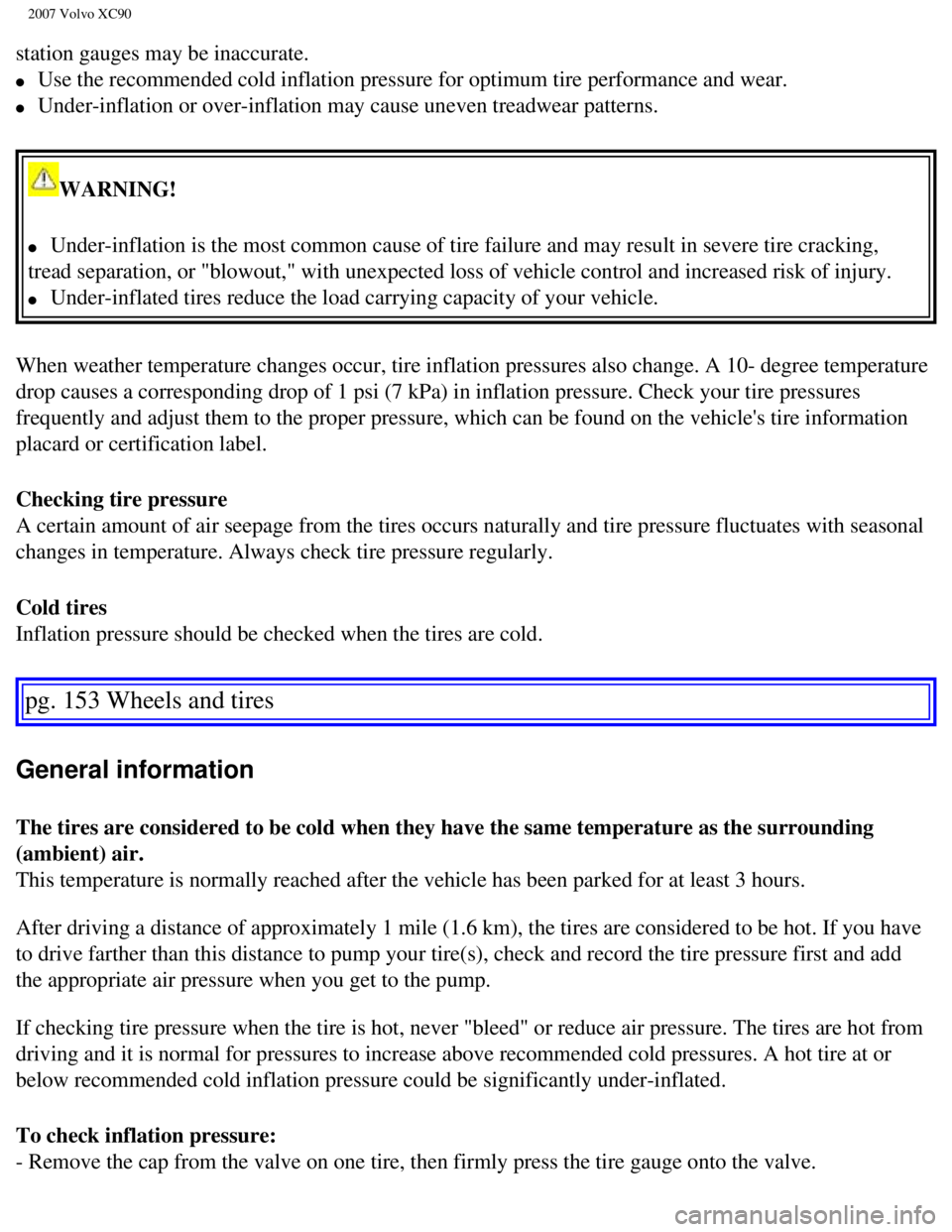
2007 Volvo XC90
station gauges may be inaccurate.
l Use the recommended cold inflation pressure for optimum tire performance\
and wear.
l Under-inflation or over-inflation may cause uneven treadwear patterns.
WARNING!
l Under-inflation is the most common cause of tire failure and may result \
in severe tire cracking,
tread separation, or "blowout," with unexpected loss of vehicle control \
and increased risk of injury.
l Under-inflated tires reduce the load carrying capacity of your vehicle. \
When weather temperature changes occur, tire inflation pressures also ch\
ange. A 10- degree temperature
drop causes a corresponding drop of 1 psi (7 kPa) in inflation pressur\
e. Check your tire pressures
frequently and adjust them to the proper pressure, which can be found on\
the vehicle's tire information
placard or certification label.
Checking tire pressure
A certain amount of air seepage from the tires occurs naturally and tire\
pressure fluctuates with seasonal
changes in temperature. Always check tire pressure regularly.
Cold tires
Inflation pressure should be checked when the tires are cold.
pg. 153 Wheels and tires
General information
The tires are considered to be cold when they have the same temperature \
as the surrounding
(ambient) air.
This temperature is normally reached after the vehicle has been parked f\
or at least 3 hours.
After driving a distance of approximately 1 mile (1.6 km), the tires a\
re considered to be hot. If you have
to drive farther than this distance to pump your tire(s), check and re\
cord the tire pressure first and add
the appropriate air pressure when you get to the pump.
If checking tire pressure when the tire is hot, never "bleed" or reduce \
air pressure. The tires are hot from
driving and it is normal for pressures to increase above recommended col\
d pressures. A hot tire at or
below recommended cold inflation pressure could be significantly under-i\
nflated.
To check inflation pressure:
- Remove the cap from the valve on one tire, then firmly press the tire \
gauge onto the valve.
file:///K|/ownersdocs/2007/2007_XC90/07xc90_07.htm (5 of 23)12/30/2006\
5:53:47 PM
Page 164 of 268

2007 Volvo XC90
Each tire, including the spare (if provided), should be checked monthl\
y when cold and inflated to the
inflation pressure recommended by the vehicle manufacturer on the vehicl\
e placard or tire inflation
pressure label. (If your vehicle has tires of a different size than the\
size indicated on the vehicle placard
or tire inflation pressure label, you should determine the proper tire i\
nflation pressure for those tires.)
As an added safety feature, your vehicle has been equipped with a tire p\
ressure monitoring system
(TPMS) that illuminates a low tire pressure telltale when one or more \
of your tires is significantly under-
inflated. Accordingly, when the low tire pressure telltale illuminates, \
you should stop and check your
tires as soon as possible, and inflate them to the proper pressure. Driv\
ing on a significantly under-
inflated tire causes the tire to overheat and can lead to tire failure. \
Under-inflation also reduces fuel
efficiency and tire tread life, and may affect the vehicle's handling an\
d stopping ability.
Please note that the TPMS is not a substitute for proper tire maintenanc\
e, and it is the driver's
responsibility to maintain correct tire pressure, even if under-inflatio\
n has not reached the level to trigger
illumination of the TPMS low tire pressure telltale.
Your vehicle has also been equipped with a TPMS malfunction indicator to\
indicate when the system is
not operating properly. The TPMS malfunction indicator is combined with \
the low tire pressure telltale.
When the system detects a malfunction, the telltale will flash for appro\
ximately one minute and then
remain continuously illuminated. This sequence will continue upon subseq\
uent vehicle start-ups as long
as the malfunction exists. When the malfunction indicator is illuminated\
, the system may not be able to
detect or signal low tire pressure as intended. TPMS malfunctions may oc\
cur for a variety of reasons,
including the installation of replacement or alternate tires or wheels o\
n the vehicle that prevent the
TPMS from functioning properly. Always check the TPMS malfunction tellta\
le after replacing one or
more tires or wheels on your vehicle to ensure that the replacement or a\
lternate tires and wheels allow
the TPMS to continue to function properly.
NOTE:
l TPMS indicates low tire pressure but does not replace normal tire mainte\
nance. For information on
correct tire pressure, please refer to the table on
page 154, or consult your Volvo retailer.
Erasing warning messages
When a low tire pressure warning message has been displayed, and the tir\
e pressure warning light has
come on:
pg. 157 Wheels and tires
Tire Pressure Monitoring System (TPMS) - option
- Use a tire pressure gauge to check the inflation pressure of all four \
tires.
- Re-inflate the tire(s) to the correct pressure (consult the tire pr\
essure placard or the table on
page 154).
file:///K|/ownersdocs/2007/2007_XC90/07xc90_07.htm (8 of 23)12/30/2006\
5:53:47 PM
Page 171 of 268

2007 Volvo XC90
WARNING!
The traction grade assigned to this tire is based on braking (straight-\
ahead) traction tests and is not a
measure of cornering (turning) traction.
TEMPERATURE
The temperature grades are AA (the highest), A, B, and C, representing\
the tire's resistance to the
generation of heat and its ability to dissipate heat when tested under c\
ontrolled conditions on a specified
indoor laboratory test wheel. Sustained high temperature can cause the m\
aterial of the tire to degenerate
and reduce tire life, and excessive temperature can lead to sudden tire \
failure. The grade C corresponds
to a minimum level of performance that all passenger vehicle tires must \
meet under the Federal Motor
Safety Standard No. 109. Grades B and A represent higher levels of perfo\
rmance on the laboratory test
wheel than the minimum required by law.
WARNING!
The temperature grade for this tire is established for a tire that is pr\
operly inflated and not overloaded.
Excessive speed, under-inflation, or excessive loading, either separatel\
y or in combination, can cause
heat buildup and tire failure.
pg. 164 Wheels and tires
Snow chains, snow tires, studded tires
Snow chains
Snow chains can be used on your Volvo with the following restrictions:
l Snow chains should be installed on front wheels only. Use only Volvo app\
roved snow chains.
l If accessory, aftermarket or "custom" tires and wheels are installed and\
are of a size different than the
original tires and wheels, chains in some cases CANNOT be used. Sufficie\
nt clearances between chains
and brakes, suspension and body components must be maintained.
l Some strap-on type chains will interfere with brake components and there\
fore CANNOT be used.
l All Wheel Drive models: Snow chains should only be installed on the fron\
t wheels. Only chains
adapted for AWD models should be used.
Consult your Volvo retailer for additional snow chain information.
file:///K|/ownersdocs/2007/2007_XC90/07xc90_07.htm (15 of 23)12/30/200\
6 5:53:47 PM
Page 172 of 268

2007 Volvo XC90
CAUTION!
- Check local regulations regarding the use of snow chains before instal\
ling.
- Always follow the chain manufacturer's installation instructions caref\
ully. Install chains as tightly as
possible and retighten periodically.
- Never exceed the chain manufacturer's specified maximum speed limit. (\
Under no circumstances
should you exceed 31 mph (50 km/h)).
- Avoid bumps, holes or sharp turns when driving with snow chains.
- The handling of the vehicle can be adversely affected when driving wit\
h chains. Avoid fast or sharp
turns as well as locked wheel braking.
Snow tires, studded tires
1
Tires for winter use:
l Owners who live in or regularly commute through areas with sustained per\
iods of snow or icy driving
conditions are strongly advised to fit suitable winter tires to help ret\
ain the highest degree of traction.
l It is important to install winter tires on all four wheels to help retai\
n traction during cornering,
braking, and accelerating. Failure to do so could reduce traction to an \
unsafe level or adversely affect
handling.
l Do not mix tires of different design as this could also negatively affec\
t overall tire road grip.
l Winter tires wear more quickly on dry roads in warm weather. They should\
be removed when the
winter driving season has ended.
l Studded tires should be run-in 300-600 miles (500-1000 km) during whic\
h the vehicle should be
driven as smoothly as possible to give the studs the opportunity to seat\
properly in the tires. The tires
should have the same rotational direction throughout their entire lifeti\
me.
NOTE: Please consult state or provincial regulations restricting the use of s\
tudded winter tires before
installing such tires.
1. Where permitted
pg. 165 Wheels and tires
Temporary spare
The spare tire in your vehicle is called a "Temporary Spare".
Recommended tire pressure (see the placard on the B-pillar or on the fu\
el filler door) should be
maintained irrespective of which position on the vehicle the temporary s\
pare tire is used.
In the event of damage to this tire, a new one can be purchased from you\
r Volvo retailer.
file:///K|/ownersdocs/2007/2007_XC90/07xc90_07.htm (16 of 23)12/30/200\
6 5:53:47 PM
Page 182 of 268
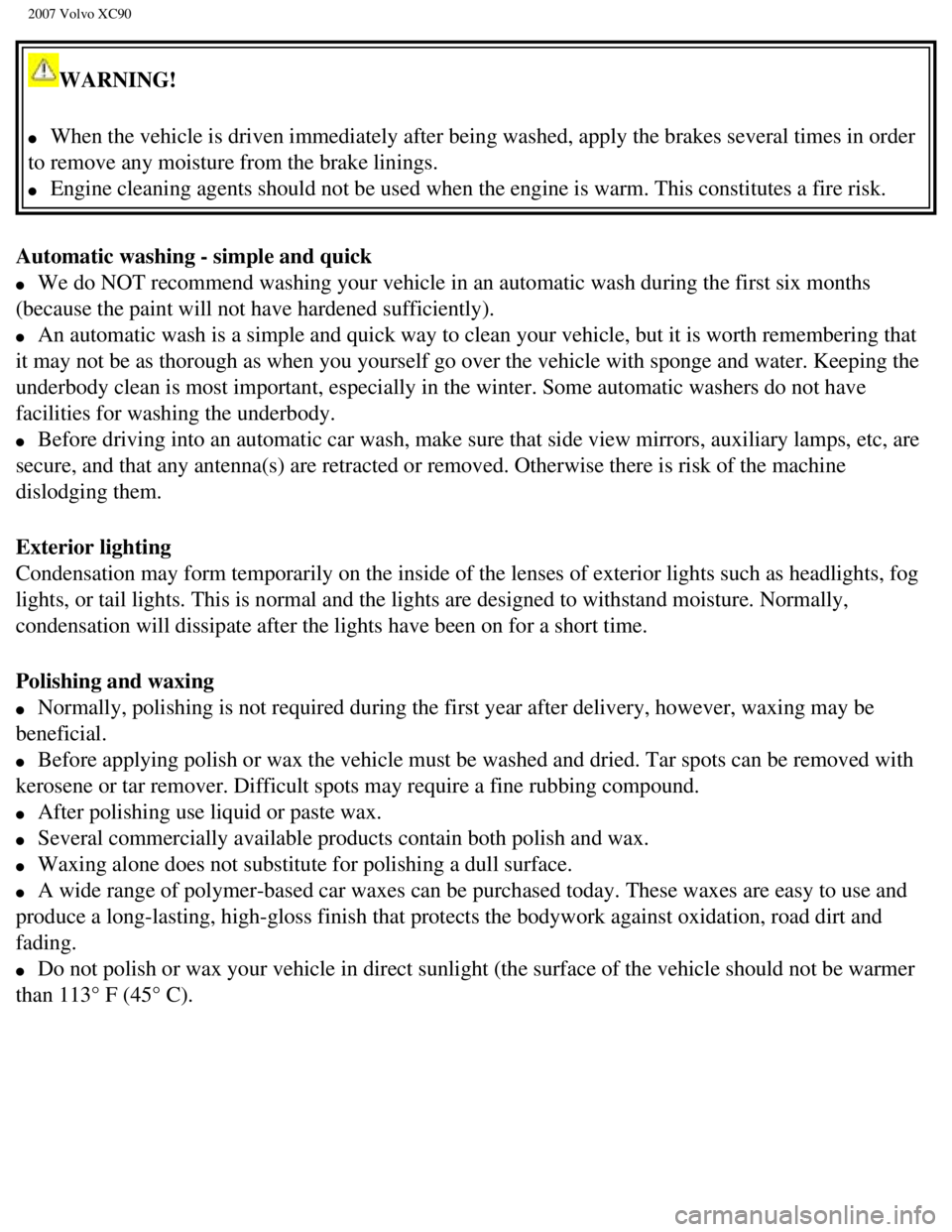
2007 Volvo XC90
WARNING!
l When the vehicle is driven immediately after being washed, apply the bra\
kes several times in order
to remove any moisture from the brake linings.
l Engine cleaning agents should not be used when the engine is warm. This \
constitutes a fire risk.
Automatic washing - simple and quick
l We do NOT recommend washing your vehicle in an automatic wash during the\
first six months
(because the paint will not have hardened sufficiently).
l An automatic wash is a simple and quick way to clean your vehicle, but i\
t is worth remembering that
it may not be as thorough as when you yourself go over the vehicle with \
sponge and water. Keeping the
underbody clean is most important, especially in the winter. Some automa\
tic washers do not have
facilities for washing the underbody.
l Before driving into an automatic car wash, make sure that side view mirr\
ors, auxiliary lamps, etc, are
secure, and that any antenna(s) are retracted or removed. Otherwise th\
ere is risk of the machine
dislodging them.
Exterior lighting
Condensation may form temporarily on the inside of the lenses of exterio\
r lights such as headlights, fog
lights, or tail lights. This is normal and the lights are designed to wi\
thstand moisture. Normally,
condensation will dissipate after the lights have been on for a short ti\
me.
Polishing and waxing
l Normally, polishing is not required during the first year after delivery\
, however, waxing may be
beneficial.
l Before applying polish or wax the vehicle must be washed and dried. Tar \
spots can be removed with
kerosene or tar remover. Difficult spots may require a fine rubbing comp\
ound.
l After polishing use liquid or paste wax.
l Several commercially available products contain both polish and wax.
l Waxing alone does not substitute for polishing a dull surface.
l A wide range of polymer-based car waxes can be purchased today. These wa\
xes are easy to use and
produce a long-lasting, high-gloss finish that protects the bodywork aga\
inst oxidation, road dirt and
fading.
l Do not polish or wax your vehicle in direct sunlight (the surface of th\
e vehicle should not be warmer
than 113° F (45° C).
file:///K|/ownersdocs/2007/2007_XC90/07xc90_08.htm (3 of 7)12/30/2006 \
5:53:48 PM
Page 184 of 268
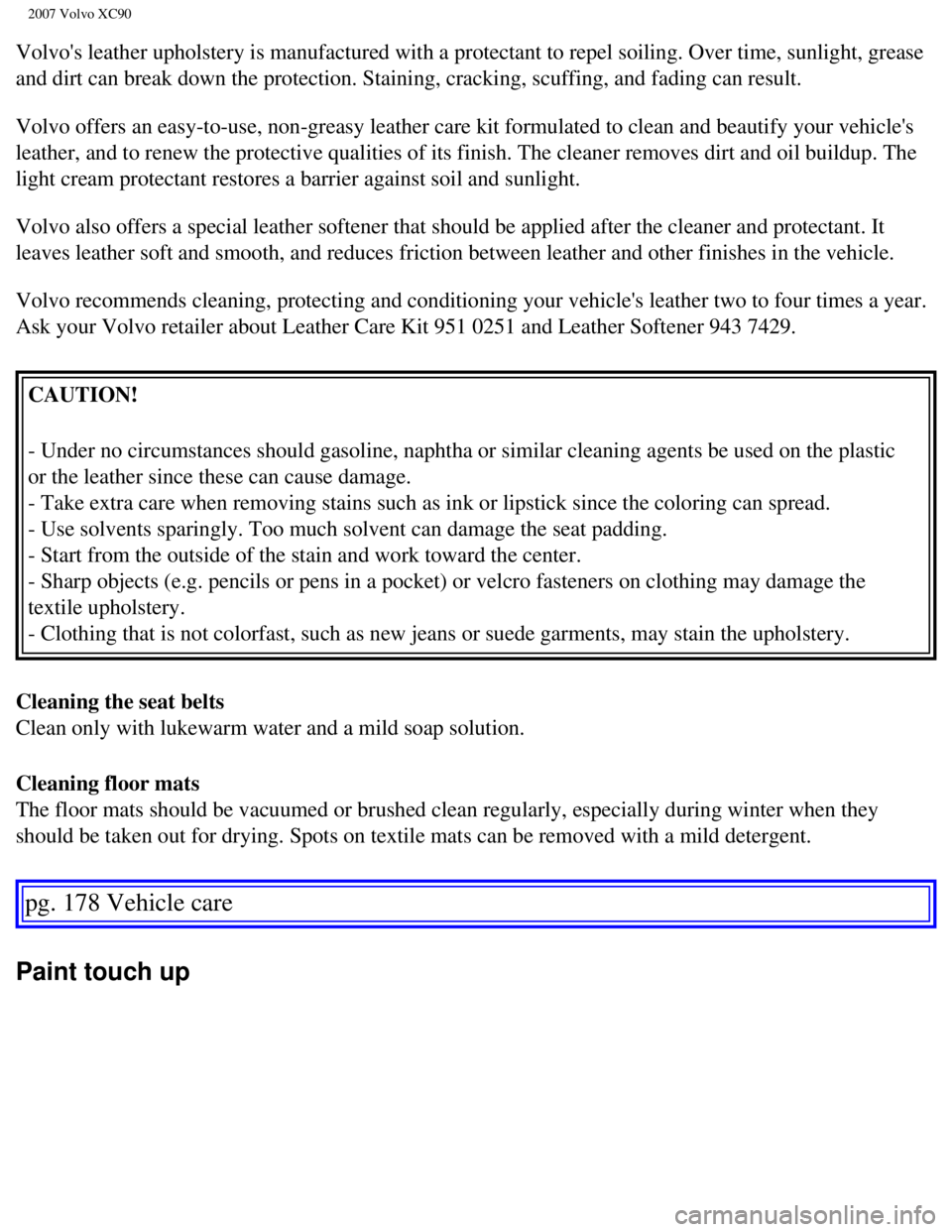
2007 Volvo XC90
Volvo's leather upholstery is manufactured with a protectant to repel so\
iling. Over time, sunlight, grease
and dirt can break down the protection. Staining, cracking, scuffing, an\
d fading can result.
Volvo offers an easy-to-use, non-greasy leather care kit formulated to c\
lean and beautify your vehicle's
leather, and to renew the protective qualities of its finish. The cleane\
r removes dirt and oil buildup. The
light cream protectant restores a barrier against soil and sunlight.
Volvo also offers a special leather softener that should be applied afte\
r the cleaner and protectant. It
leaves leather soft and smooth, and reduces friction between leather and\
other finishes in the vehicle.
Volvo recommends cleaning, protecting and conditioning your vehicle's le\
ather two to four times a year.
Ask your Volvo retailer about Leather Care Kit 951 0251 and Leather Soft\
ener 943 7429. CAUTION!
- Under no circumstances should gasoline, naphtha or similar cleaning ag\
ents be used on the plastic
or the leather since these can cause damage.
- Take extra care when removing stains such as ink or lipstick since the\
coloring can spread.
- Use solvents sparingly. Too much solvent can damage the seat padding. \
- Start from the outside of the stain and work toward the center.
- Sharp objects (e.g. pencils or pens in a pocket) or velcro fasteners\
on clothing may damage the
textile upholstery.
- Clothing that is not colorfast, such as new jeans or suede garments, m\
ay stain the upholstery.
Cleaning the seat belts
Clean only with lukewarm water and a mild soap solution.
Cleaning floor mats
The floor mats should be vacuumed or brushed clean regularly, especially\
during winter when they
should be taken out for drying. Spots on textile mats can be removed wit\
h a mild detergent.
pg. 178 Vehicle care
Paint touch up
file:///K|/ownersdocs/2007/2007_XC90/07xc90_08.htm (5 of 7)12/30/2006 \
5:53:48 PM
Page 195 of 268
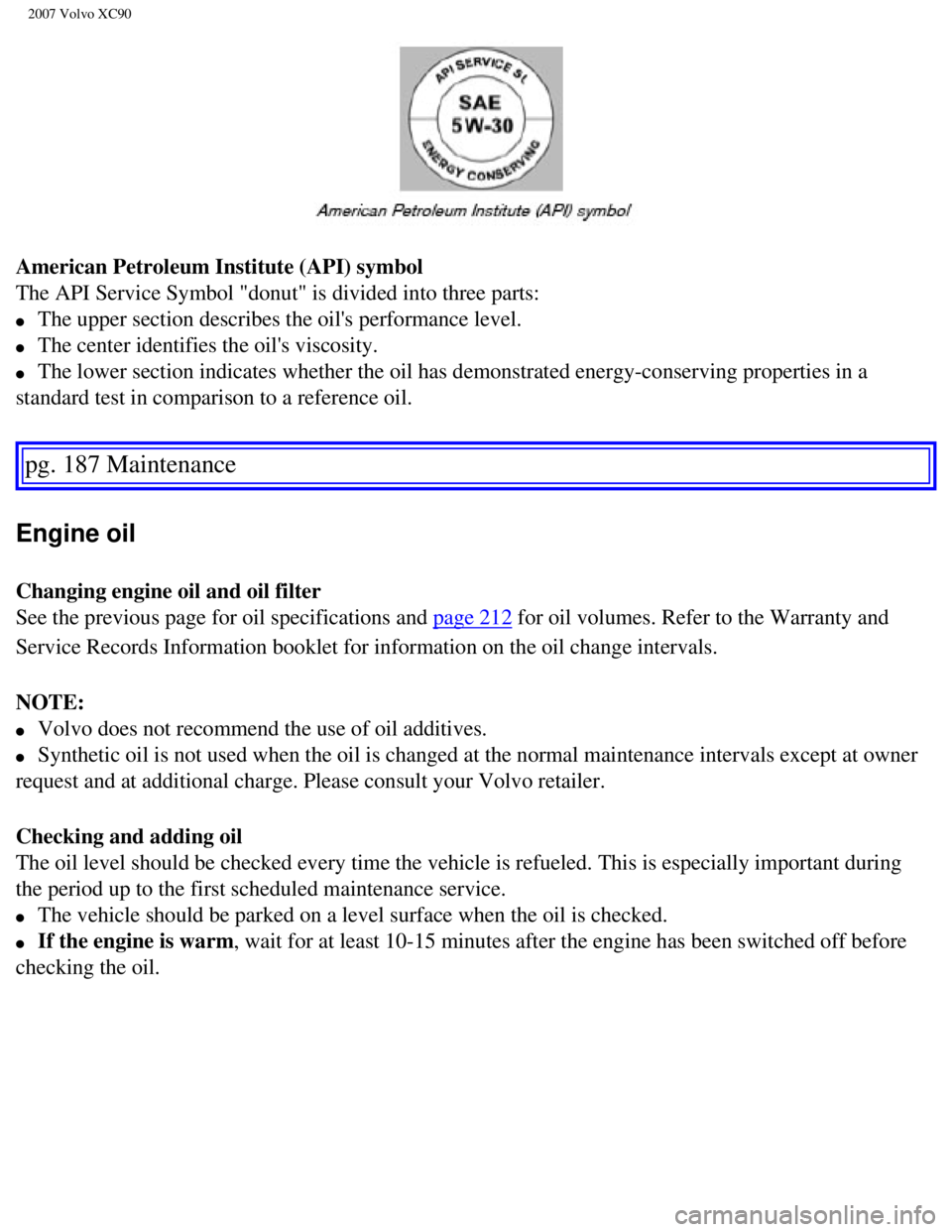
2007 Volvo XC90
American Petroleum Institute (API) symbol
The API Service Symbol "donut" is divided into three parts:
l The upper section describes the oil's performance level.
l The center identifies the oil's viscosity.
l The lower section indicates whether the oil has demonstrated energy-cons\
erving properties in a
standard test in comparison to a reference oil.
pg. 187 Maintenance
Engine oil
Changing engine oil and oil filter
See the previous page for oil specifications and
page 212 for oil volumes. Refer to the Warranty and
Service Records Information booklet for information on the oil change in\
tervals.
NOTE:
l Volvo does not recommend the use of oil additives.
l Synthetic oil is not used when the oil is changed at the normal maintena\
nce intervals except at owner
request and at additional charge. Please consult your Volvo retailer.
Checking and adding oil
The oil level should be checked every time the vehicle is refueled. This\
is especially important during
the period up to the first scheduled maintenance service.
l The vehicle should be parked on a level surface when the oil is checked.\
l If the engine is warm, wait for at least 10-15 minutes after the engine has been switched off\
before
checking the oil.
file:///K|/ownersdocs/2007/2007_XC90/07xc90_09.htm (9 of 37)12/30/2006\
5:53:50 PM